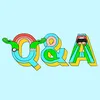The Impact of RuPaul's Drag Race on YouTube
Jun 10, 2021 – [[read-time]] minute read

Jun 10, 2021 – [[read-time]] minute read
Competitive lip syncs, fierce runway shows, and the Snatch Game have all become synonymous with "RuPaul’s Drag Race," the VH-1 reality show that turns its drag queen contestants into celebrities and household names. As the show has exploded in popularity and spread around the world, it has played a major role in taking drag from nightlife to mainstream, commercial entertainment.
The show’s impact is certainly felt on YouTube. Among the more than 500 channels in the drag community are many "RuPaul’s Drag Race" alumni and non-contestant queens reviewing episodes. There are also fans of the show who bring their analysis and commentary to the masses.
In the U.S., views of videos from channels in the drag community increased more than 45% in 2020.
These channels took on new relevance in the last year. As in-person drag shows were canceled amidst the pandemic, an increasing number of people turned to queens’ YouTube channels. In the U.S., views of videos from channels in the drag community increased more than 45% in 2020.
The type of content these channels are producing also reflects drag’s movement into the mainstream, with many queens using their channels to build their brands and become entrepreneurs in their own right. Among the most popular formats are makeup tutorials and transformations that highlight the strong ties between the beauty industry and drag. These include podcasts and talk shows like WOWPresents’ popular UNHhhh and Willam Belli’s Beatdown series, and commentary and recaps of RuPaul’s Drag Race episodes from both former contestants and non-contestants alike.
We talked with three up-and-coming creators in the drag community to find out how they’re growing their channels and the changes they’ve seen play out over the last year.
How do you decide which queens to interview?
Joseph Shepherd: I normally decide based on who I believe has a good story or who I personally connect with. I interviewed Kameron Michaels and she identifies as being an introvert. Then I had Blair St. Clair on, and she was talking about a sexual assault she experienced. Anytime somebody has something to help other people with, or that other people can watch and be like, ‘I’m going through this as well—you’re a success, so I can be a success’—that’s a big factor [in my decision process].
How have you seen the drag community on YouTube evolve since you started your channel?
What made you decide to start your channel?
Kimora Blac: I’ve been doing drag for a long time. At the center that entire time was my love for makeup and how makeup has taken me from coming out and being who I am as Kimora. YouTube has always been a goal of mine to showcase my artistry to the world. It’s been a place where I knew I was just in the right place at the right time.
People forget that when you do drag and perform, putting yourself in front of a camera is one of the last things you want to do—because you’re in shows, you’re traveling, and you’re doing things for yourself in person, so being in drag at home is not something that’s necessarily a priority. But for me it is a priority. It is something that’s a part of the job for me. I think it’s important for drag queens to showcase what they are doing at home, because people are curious.
Is there anything your audience consistently asks to see in a video?
Kimora Blac: Oh yeah, they like transformations. Whether I’m with a beard in the morning turning into myself as Kimora—they just love to see the transfer from point A to point B. For me, it’s repetitive because I do it twice a week, but for someone else, it’s new. That’s what I always need to keep in the back of my mind, that there’s always someone watching that has not seen this yet.
How have you seen the drag community online change over the last year as a lot of in-person shows were canceled?
Bussy Queen: Drag and really the nightlife scene of any type of performer was just completely shut down by the pandemic. I think a lot of people in that space found themselves needing a creative outlet, because as a drag performer, your primary source of income and thing you do is entertain. YouTube as an outlet to both be creative and entertain, and potentially earn some money, was I think the perfect place to do all those things.
Are there any misconceptions about drag that you hope to tackle head on in your videos?
Bussy Queen: I think a lot of people do want to relegate drag to the nightclub scene, so I think having this space on YouTube to be able to do drag and express myself as a drag character in the way that I want, when I want, and how I want is really important to show people that drag isn’t just five nights in a club a week, from 9 p.m. to 4 or 5 in the morning. It can be recording videos and producing content. It can be acting—it can be literally anything you want.